Note: We’ll receive commissions for purchases made through the Amazon links in this post.
Over the years we’ve had many customers who were either new to the horse world or purchasing their first miniature horse. This guide will walk new owners through caring for their miniature horse(s). As always, if you have any questions, please reach out to us!
Watering Miniature Horses
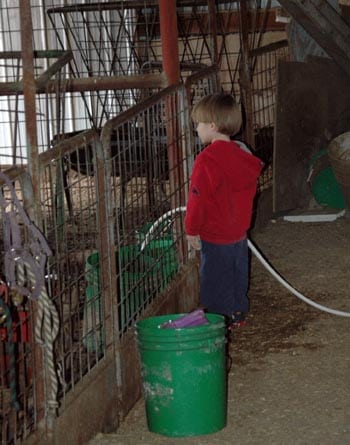
All livestock should access to clean water all the time. Be sure to have a bucket in their stall or trough in their lot or pasture with water. An animal can live for days without feed but will die quickly without water.
Feeding Grain to Mini Horses
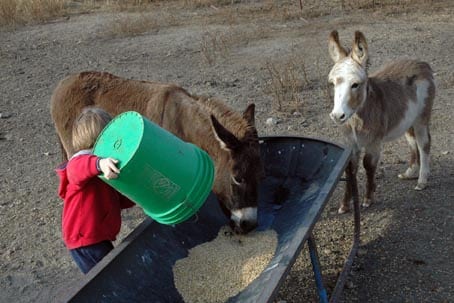
Feed according to the instructions on the feed bag that you choose. It varies across manufacturers, but we feed about 1-2 pounds of whole oats per 100 pounds of the horse’s weight. We split this amount into two feedings: morning and evening. A full-grown miniature mare around 30″ tall will weigh around 200-250 pounds, so we would feed about three to four pounds of grain per day.
If they have good grass, you can cut back on the grain. If they are losing weight, increase feed gradually. We feed whole oats to our broodmares and if they don’t gain enough weight we supplement with alfalfa cubes. When we feed alfalfa cubes, we soak them in water for about an hour before feeding. Then we’ll usually feed about a hand full of the alfalfa. If a horse develops a pot belly it is usually from lack of nutrition, or too little feed, NOT overfeeding.
For young horses, weanlings and yearlings, there are many excellent feeds for growing animals. I highly recommend Purina Equine Junior.
Letting your Miniature Horses Graze
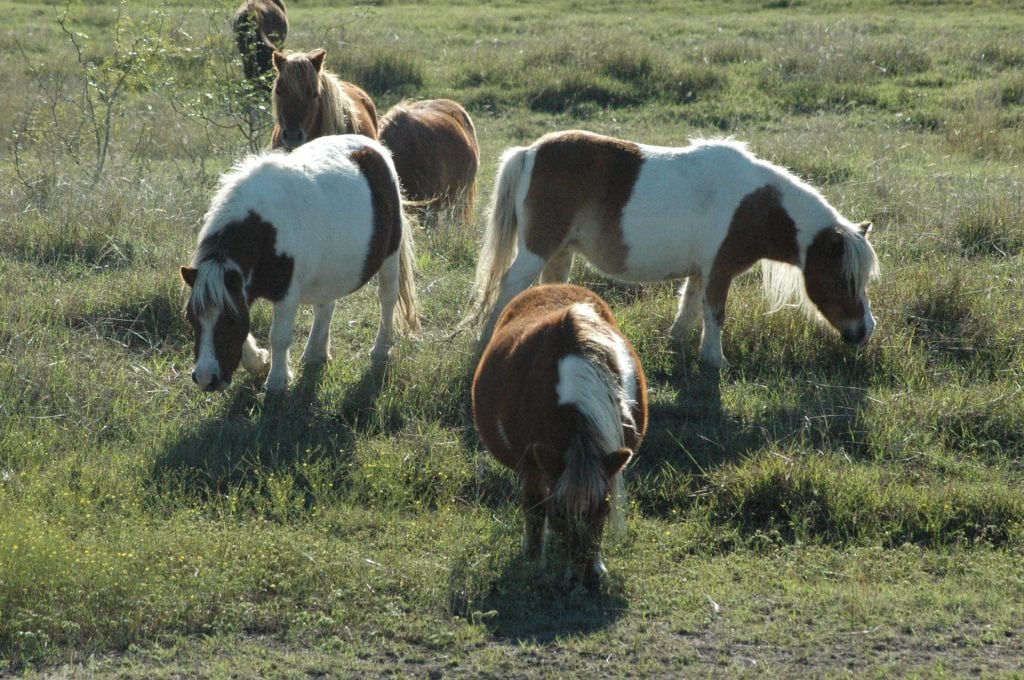
I suggest free access to coastal Bermuda grass hay when the grass is lacking. That said, they probably will not even eat it when the grass is available because they prefer fresh growing grass. Because of the drought we are going through, I would introduce them to the grass gradually. Perhaps letting them graze an hour or two a day for the first few days and gradually increasing the time.
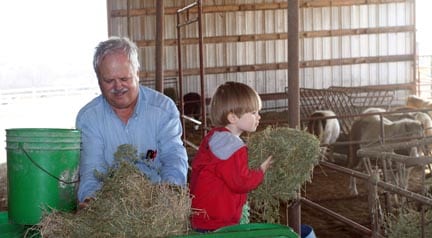
Once they are used to it, you can leave them on the grass. That said, you may want to limit their time for the grass’s sake so you don’t create a dry lot from overgrazing.
Protect any trees in their lot as they will sometimes eat the bark out of boredom which can kill the tree. In the past, we have wrapped chicken wire loosely around trees in the lot to protect them.
Salt for Your Mini Horse
Salt should also be available. Salt blocks, available at feed stores or Tractor Supply, come in three types:
I recommend and use only the brown blocks which supply some of the minerals that the horses may need. They are available in 50-pound blocks and in smaller individual blocks of about four pounds.
Worming Miniature Horses
We worm our horses every two to three months with a paste wormer that can be purchased at your local feed store. The tube is marked to administer by weight and one tube usually worms a full-sized horse of 1,250 pounds. That same tube will take care of a miniature five times, so set the gauge to 250 pounds.
Ivermectin is the wormer we use most of the time. However, your veterinarian may suggest that you rotate wormers so that they don’t build up a resistance to one type or another. DO NOT use Quest wormer. It is very specific as to weight and has been fatal in some instances if overdosed. Most other wormers have a wide tolerance and even accidental dosing of an entire tube would not be fatal.
Vaccinations and Hoof Trimming for Mini Horses
Every area has its own needs as far as vaccinations. I only give an annual booster of FluvacEWT, but in your area, your vet might recommend additional vaccinations.
Hoof trimming should be done usually every two to three months as needed, depending on the individual horse. Find a farrier in your area through references or feed store.
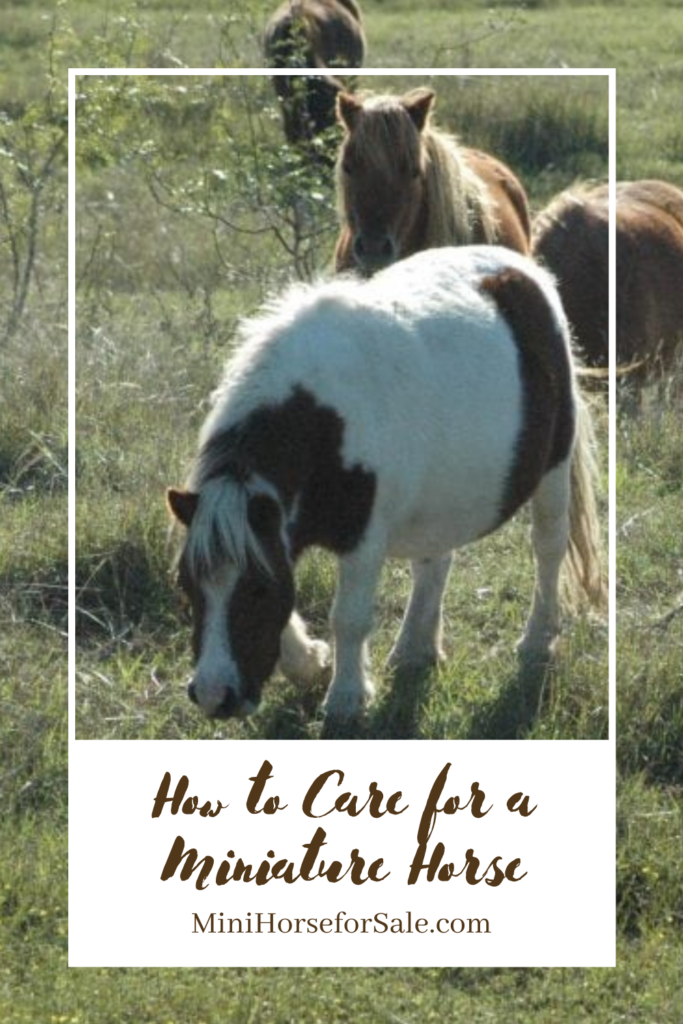
Here is a good piece written by a friend of mine, Joanne Ross, which may be of interest too:
General Care and Health of Mini Horses
- Miniature horses consume the same feeds as full-sized horses. These are primarily pasture grass, hay, and grain.
- A single miniature horse can be reasonably maintained on as little as 1/4 acre of land provided that its feed is supplemented with hay on a daily basis and the horse is also provided with a structure for shade or to get in out of the rain or other inclement weather conditions
- Miniature horses, depending on their age, size, and whether they are also on pasture, will consume in the range of two to five pounds of good quality hay per day.
- Generally, hooves of miniatures are trimmed at two-month intervals. This may be necessary more often with younger horses (yearlings and younger) while they are growing to assure proper bone development, leg conformation, and gait.
- Horses are usually wormed on a two-month routine with one of the modern wormers or fed the daily supplement that has a wormer included.
- Veterinarians should be consulted for advice on annual vaccination programs for horses to prevent common diseases. Annual dental care is very important in miniatures.
- In the winter the miniature horse gets a very long coat and it can be very deceiving about how their weight is holding. It is important to actually check the horse’s condition by rubbing the fingers across the ribs of the horse just below the backbone. If a “washboard” feel is evident, the horse is probably underweight and the feed ration should be increased.

